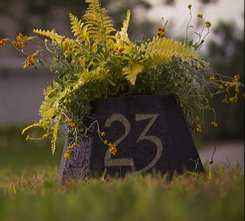By Sean Conway

Concrete footing, leftover from a construction project, has been transformed into a planter stenciled with a house address
When most of us hear the word "recycling," we tend to think of paper, aluminum and even certain kinds of plastics. But concrete?
Concrete is the world's most commonly used building material, but most of us aren't aware that it is highly recyclable. Instead of ending up in the landfills, most concrete today is reused, ground into gravel or remade into cement mix.
Even better than recycling concrete is repurposing it. All sorts of prefabricated concrete building elements are left over after a construction project. With a little creativity, you can turn these leftovers into something special for your yard.
A leftover concrete footing can be recycled into the perfect house marker, planted and stenciled with house numbers. Unused cinder blocks can be planted and used to edge a garden bed or a wall. Cement junction boxes that look like much pricier modern planters are perfect when planted for a doorway.
Don't worry that new concrete doesn't look "natural" right now: Over time, it takes on a lovely aged patina, accumulating mosses and lichens while offering maximum durability and minimal maintenance.
The materials you need for the project include recycled cinder blocks, junction boxes, or deck footings; hardware cloth or a screen; cement floor paint; number stencils; newspaper; spray adhesive; spray paint; soil mix of compost, bark, vermiculite and lava rock; and assorted plants.
Tools you'll need are a drill with a tile or masonry bit, and metal snips.
Start by checking your recycled cement container for a drainage hole. If the hole is too large or open at the bottom, cut a square of hardware cloth slightly larger than the hole. Make sure you leave the sharp edges in place. The sharp points will attach to the coarse texture of the cement and keep the screen in place. Simply push the screen into place to block the hole.
If there is no drainage, use a drill and masonry bit to make several drainage holes in the bottom of the container.
To paint your container, use a cement floor paint found at any hardware store. Follow the recommended directions for applying the paint.
To stencil your container, apply a light layer of spray adhesive to the back of your stencil. Allow the adhesive to dry; when the surface is tacky, position your stencil on the container. Carefully press down all the edges with your fingers. Use newspaper to block off any areas not covered by the stencil to prevent overspray. Apply two or more very light coats of spray paint and remove the stencil. Let the paint dry overnight before planting.
Your concrete container is likely to be much heavier than a conventional planter, so it's best to create a soil mix that is light. Use equal parts vermiculite, lava rock, compost and composted bark. This will create a soil mix that is light and nutritious for the plants in your container. If weight is not an issue, a regular container potting mix is fine.
Choose plants that suit your container's site. Because cement is slightly alkaline (the limestone in the mix) and porous, you want to choose plants that prefer a sweet, well-drained soil, like rock or alpine plants, or sedums and cactuses.
If you have a square planter you need to make sure one side has low light plants or plan to rotate the container periodically to assure even growth.
© Cultivating Life by Sean Conway
AUTOS | HOBBIES | EDUCATION | FAMILY | FASHION | FOOD & RECIPES | HOME DECOR | RELATIONSHIPS | PARENTING | PETS | TRAVEL | WOMEN
Home & Garden - Concrete Ideas on Turning Construction Leftovers into Garden Fixtures